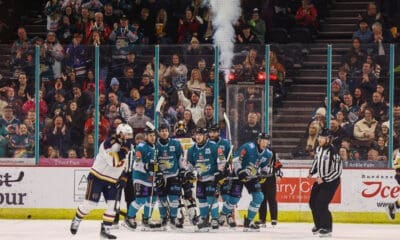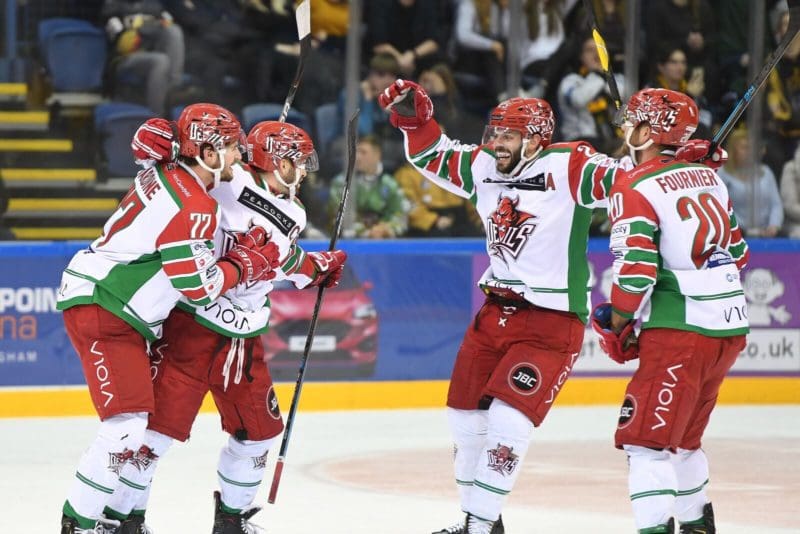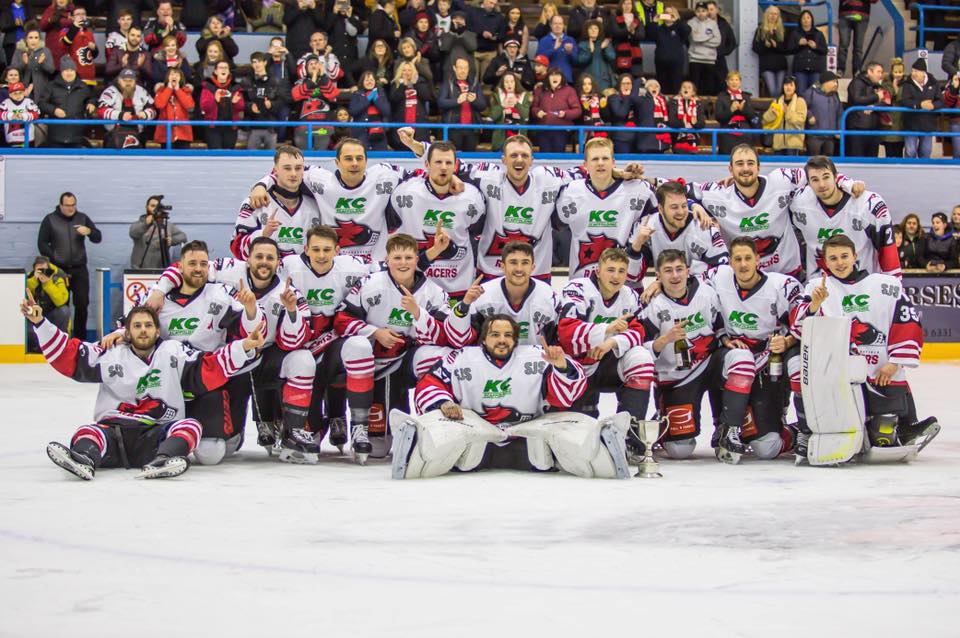 |
| Thomas Stuart-Dant in action for Sutton |
As NIHL North continues to improve, the question of ‘imports’ in the league has raised its head in recent weeks.
While some teams focus on improving their British-born players, others have added imports in the hope this will boost their chances of success.
Players such as Thomas Stuart-Dant (Sutton Sting), Juraj Senko (Solway Sharks) and Lukas Zeman (Manchester Minotaurs) have made an immediate impact in NIHL North and represent major coups for their respective teams.
While signing imports is no guarantee of success, it’s widely recognised a good one can be worth their weight in gold both on and off the ice. It could also be argued there’s a certain mystique and prestige attached to icing decent imports.
NIHL South teams embrace the idea, with the top teams usually running with two throughout the season. Last season’s champions Chelmsford Chieftains are a useful yardstick when compared to a number of Northern clubs in terms of size, their fanbase and potential turnover. Pete Lewis was involved with the club in various capacities for nearly a decade, so C2C asked him how they went about having imports on their roster:
C2C – In the last two seasons Chieftains have had quality imports in Julius Sinkovic, Tibor Schneider and Daniel Volrab. What are some of the costs involved?
PL – Generally speaking you have to pay their flights as well as contributing to them going home at Christmas/New Year and if they go home in the summer. You also need to provide accommodation, although a lot of the time fans will put up players for a donation or contribution from the club. This was even done for Brits who have to relocate such as Mike McKay last year.
C2C – Surely those costs make this a risky strategy?
PL – They don’t come cheap in terms of wages but to be successful on and off the ice, you need to spend money to make money. The club spends more on leafleting, posters, advertising etc and really encourages fans to get their friends to come along. The advantage Chelmsford has over a lot of clubs is our junior system is so successful, so a number of the guys grow up playing together and don’t consider going elsewhere to play their hockey, so generally play for not much more than ‘beer money.’ A lot of fans of other clubs won’t/don’t believe this, but it’s true. If you have a good strong nucleus of players that want to stay playing together, then you don’t need to spend a fortune on wages and costs.
C2C – So what sort of quality can be brought in?
PL – The way things are run frees up some more cash for the ‘next level’ of imports. Although we, as a fanbase, loved the likes of Rudi Dzurko and Jerry Pavlus, it was obvious we’d need to upgrade on them if we wanted to win NIHL1 after going unbeaten in NIHL2 a few years back. They were cheap as they were local and already living here, but they were also not in the same class as the likes of Sinkovic, Schneider and Volrab.
C2C – How much of this is supported through sponsorship?
PL – Chieftains are growing in terms of sponsorship year-on-year, so the extra income is spent supporting the team with things like coaches to away games, which saves the guys having to drive and be a bit more tired before the games. It’s the little things like that take a team from being competitive to being the team to beat. Sponsors are also supporting the club and staying on board for longer than in previous years.
There were times when we’d get a sponsor and the following year they wouldn’t renew their sponsorship. The club is also very fortunate to have a large number of fans who put their hands in their pockets for things like shirt sponsorship. This year the club had their first ‘Own and Loan’ so sponsorship went from £250 for home and £250 for away shirts, to £300 for home shirts, £200 for away shirts and £100 for warm-up shirts. This has brought in a fair bit more cash than previous years which has helped with the upfront costs at the start of the season.
C2C – How much does it cost to get in to home games? Would reducing prices and targeting ‘lesser’ imports be an option?
PL – It’s £10 for adults and £5.50 for kids, although the armed services are offered free entry through the Tickets for Troops scheme. The club are unlikely to drop prices as crowd numbers are increasing and although extra people may come through the door, it’s not guaranteed, so it would be prudent to keep things balanced and constant rather than risk losing income. If the club was losing huge sums of money, like we did in the EPL days, they would have looked at how to reduce costs, but while they’re sufficient and sustainable, there’s no point in rocking the boat and risking losing what they’ve worked hard to build up.
C2C – What’s your average attendance?
PL – Early on in the season, gates struggle to get to 300 unless it’s a big local game, but as the season goes on the average is around 400-450. When the likes of London, Wightlink and Invicta are in town, it’s not been unknown to reach 800 through the door. In fact within the last couple of years there were over 1100 in on three occasions against London/Romford Raiders.
C2C – Do you feel imports are of benefit to NIHL?
PL – I think if they’re the ‘right’ import, they definitely help both on and off the ice. In recent seasons Chelmsford had the likes of Andrew Hannah and Dwayne Newman who were massively influential on the players they played alongside. You could see during games them pointing out where ‘D’ men should be and what the forwards should be doing. In particular I remember one game where Hannah ‘coached’ Alex Staples during a passage of play, then at the next break as they skated to the bench they were deep in conversation about positioning and why it was important to get it right. It’s those little things that aid a young players’ development.
It’s also important the imports concentrate on their own game and do their job well on the ice too. It’s all well and good scoring 5+1 a game, but if the team loses it’s pretty pointless. I think the EIHA has done a lot in recent years, especially at NIHL level, to help stop ‘cricket scores’ being the norm by lowering the goal difference tie-breaker to further down than head-to-head scores. Would I like to see more imports in the league? For this level I think 1-2 per team is about right, but only if they’re the right ones who bring something more than just playing skills to the club.











